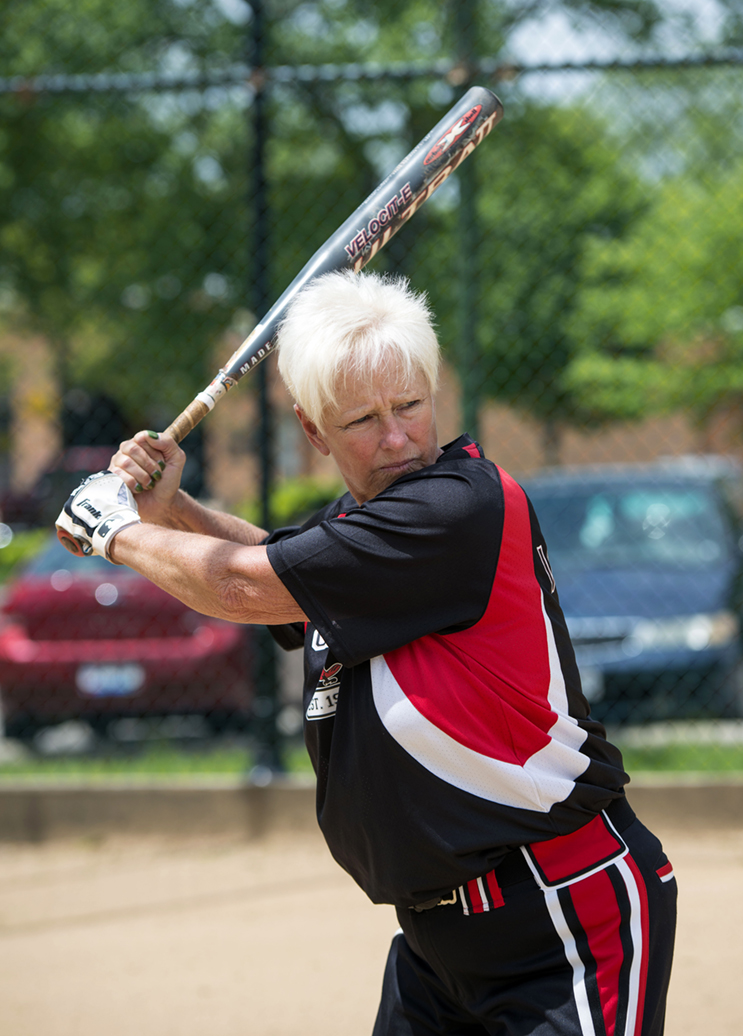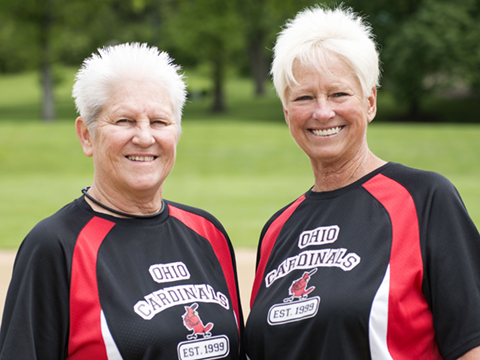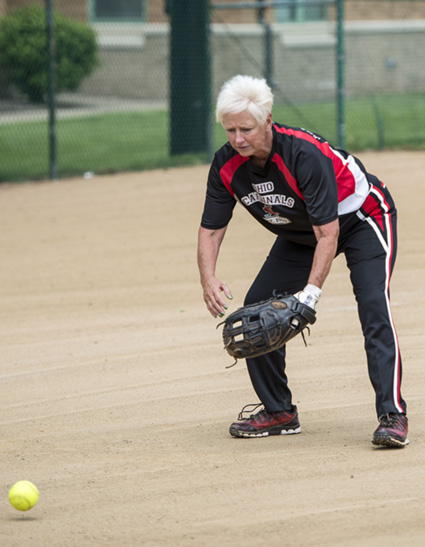
Jan's story
Spondylolisthesis
There is a philosophy that runs deep in the senior women's softball leagues. Play with pain if necessary, get the problem fixed, and get back out onto the field.
"After the season's over we get our back operations, our knees replaced, our hand surgery, or whatever we need to do," says Jan, who has been playing competitive slow-pitch softball in the senior leagues for more than 15 years. "People say, 'Why don't you just quit?' Well, we don't want to. This is our passion."
Jan, in her mid-60s, had both of her knees replaced as a matter of course. But for years she drew the line at getting help with her back. Back surgery, she feared, would mean the end of her softball career. She had been suffering for six years with pinching sensations that sent "stingers down both legs" when one of her long-time teammates on the Ohio Cardinals inspired her to see Michael Kachmann, MD, a neurosurgeon with Mayfield Brain & Spine.
Jan's teammate, Peggy, had also suffered from back pain, but Peggy had decided fairly quickly that she wasn't going to put up with it. "I didn't want to have that discomfort," Peggy recalls. "I wanted to get it fixed, and he said he'd fix it. I had my surgery in June, and I was playing pickle ball in three weeks."
She was back in the softball lineup in two and a half months.
Jan took notice. "I was so impressed with her progress, her lack of pain, and how highly she spoke of Dr. Kachmann, that I thought maybe I should do this."
Hedging her bets, Jan made an appointment with both Dr. Kachmann and a spine surgeon with another practice. Both surgeons agreed on the diagnosis. Jan had a significant injury at L-3-4-5: stenosis involving three discs in her lower back and spondylolisthesis involving two of the discs. SPON-dill-oh-lis-THEE-sis is the forward displacement of one vertebra over another. Or, in Jan's description, "You have a situation where one vertebra slumps over the other."
The second surgeon presented a traditional solution: a surgical approach that involved opening the back and cutting through the muscle. Dr. Kachmann presented a different option: an XLIF/PLIF that involved navigating a clear path from both the side and the back, with no cutting of muscle.
"I decided on the minimally invasive surgery with Dr. Kachmann," Jan says. "I said, yes, let's do it. And it was the best decision I have ever made."
Although the procedure is described as "minimally invasive," it is not a small procedure. In Jan's case, it would require five small incisions and the insertion of two rods, six screws, and two cages. It would involve three bone grafts and bone marrow from her hip. There would also be some bruising that resulted when Dr. Kachmann gently moved organs so that he had a clear surgical approach to her spine.
In short, it would be a much bigger procedure than Peggy's, a fusion at L-3-4 that required four screws and one cage.
The XLIF/PLIF: eXtreme Lateral Lumbar Interbody Fusion and Posterior Lumbar Interbody Fusion

"The lateral approach (XLIF) takes advantage of gravity in moving the abdominal organs out of the way and creating a natural corridor to the lateral part of the spine," Dr. Kachmann explains. "This approach has very little dissection and no cutting of muscle. The cages inserted are much larger than what we can use in posterior (from the back) approaches, and they open up the spinal canal in an indirect fashion.
"This allows the posterior portion of the surgery (PLIF) to be percutaneous (through the skin) in nature for the placement of the screws, again with muscle-splitting techniques. The lack of muscle dissection and cutting means the patient experiences much less pain, very little blood loss, and a quicker recovery. This surgical approach has not only changed my patient's lives, it has changed mine as well."
Nevertheless, Dr. Kachmann made no promises that Jan would be back fielding line drives at third base. "He made me cry because he couldn't guarantee that I'd ever play softball again," Jan says. "He thought I could, but he wasn't positive about third base."
Like Peggy, Jan had her surgery at TriHealth's Bethesda North Hospital. The surgery took 2 ½ hours, and Jan was out of bed and walking the next day. She was circling the floor and preparing to go home when she saw Dr. Kachmann approaching. "I almost ran down the hall to see him," Jan recalls.
Dr. Kachmann raised his hand like a traffic officer and shouted, "Slow down!"
Jan began cutting back on pain medications that day and was off all pain medications within a week. For her, the worst pain was in her hip. During surgery, while she was under anesthesia, Dr. Kachmann used a needle to extract a small amount of bone marrow from her hip. He then spread the marrow over the bone grafts to promote healing.
Jan says she liked Dr. Kachmann's frankness. "He doesn't mess around. He's serious, intelligent, and up on the latest. After surgery, I wasn't allowed to bend – this is where my strict Dr. Kachmann comes in – I was not allowed to bend, lift, twist, or carry anything. But I was able to walk. Walking was my therapy. When I tried to get him to let me play ball at the end of January, he said absolutely not."
Dr. Kachmann also advised Jan to stop lifting weights and to adopt more modern strengthening exercises, including planks and other core exercises that do not involve twisting or bending.
The results have been worth celebrating. Four months after surgery, Jan was throwing softballs and taking her turn in the batting cage. At six months, she was looking forward to her first tournament since her surgery. Her six-month follow-up x-rays were "picture perfect" in the words of physician assistant Kate Walters.
"I still have some lower back pain because of my arthritis, but it has nothing to do with the pain I had before in my legs," Jan says. "The amount of pain that's gone is unbelievable."
Jan batted .750 in that first tournament after surgery and, best of all, she was back where she belonged, at third base.
~ Cindy Starr
Hope Story Disclaimer -"Jan's Story" is about one patient's health-care experience. Please bear in mind that because every patient is unique, individual patients may respond to treatment in different ways. Results are influenced by many factors and may vary from patient to patient.


photography by Joe Simon
